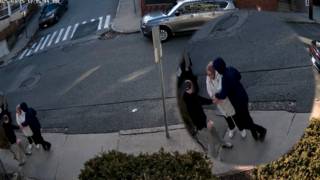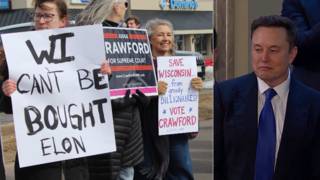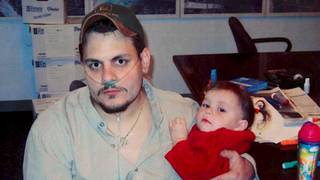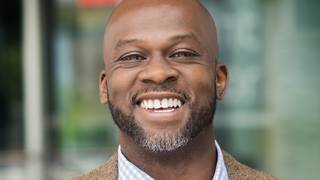
Topics
A new Sierra Club report raises new questions about the Bush administration’s handling of the cleanup of downtown Manhattan in the days after 9/11. We’ll speak with the author of the report and a downtown Manhattan resident who suffers respiratory illness from World Trade Center dust. [includes rush transcript]
As Republicans prepare to descend on New York City for their party Convention in less than two weeks, a leading environmental group is raising new questions about the Bush administration’s handling of the cleanup of downtown Manhattan in the days after 9/11.
A new report by the Sierra Club charges that the Bush administration was guilty of reckless disregard by failing to inform Ground Zero area workers, residents and rescuers of health risks from toxic air after the collapse of the World Trade Center.
The report titled “Air Pollution and Deception at Ground Zero” blames the thousands of cases of long-term respiratory illness among New Yorkers on the White House and the Environmental Protection Agency, saying they downplayed health risks, shirked their regulatory oversight roles and even urged financial district workers to return to their jobs prematurely.
The EPA called the report “a blatant attempt to use this tragedy for political gain.”
In addition to misleading the public about the health hazards of the smoke and dust at Ground Zero, the report finds that the Bush administration’s mistakes are now in danger of becoming policy for handling future disasters.
- Suzanne Mattei, an attorney who heads the national field office of the Sierra Club in New York. She is the author of the Sierra Club’s new report “Air Pollution and Deception at Ground Zero.”
- Jo Polett, downtown Manhattan resident who lives near Ground Zero. She has was been diagnosed with reactive airways disease and GERDS from World Trade Center dust in her apartment. She is a member of the group 9/11 Environmental Action.
Transcript
JUAN GONZALEZ: With us today to talk about that are the author of the report, Suzanne Mattei, an attorney who heads the national field office of the Sierra Club in New York. She’s the author of “Air Pollution and Deception at Ground Zero.” We’re joined by Jo Polett, a downtown Manhattan resident who lives near ground zero. She has been diagnosed with Reactive Airways Disease and GERDS from World Trade Center dust in her apartment. Welcome to both of you.
SUZANNE MATTEI: Thank you. Glad to be here.
JUAN GONZALEZ: Suzanne, there have been quite a few reports in recent years about the federal government’s handling of the environmental problems at ground zero. Could you summarize what are some of the new findings that your report has put together—it’s a 184-page report, it’s quite comprehensive, it took me about a day to read it. Luckily, I was able to get an advance copy, and — but tell us about some of the findings?
SUZANNE MATTEI: Sure. Well, when I first started this report, I thought I would find some political spinning of a few early press releases followed by some bureaucratic bungling, and I thought it would take me maybe four months to write this thing. Instead it took over a year because I found a lot more than that. I found that E.P.A did not find hazards because they did not look for them, and when they did find hazards, they either didn’t tell us, or they came up with very lame excuses for why we shouldn’t be concerned. It was layer upon layer of deception and disregard. I found out that E.P.A had surveyed their own employees, their office employees, who work at 290 Broadway, which is maybe seven blocks away from the towers. They found out that they were sick in December, three months after the attack. Long after E.P.A had told everybody, come back, come back to lower Manhattan, told families come back, bring your kids, everybody was told to return. They find out their own employees are sick. But I had never heard of that study. Nobody else I knew, nobody else that I talked to had ever heard of that study. I went through E.P.A’s press releases. Nothing. No word about this study, but it was published in a scientific journal. E.P.A. knew about it.
Editor’s Note: Following the show Mattei contacted Democracy Now with the following correction: “I referred to EPA knowing that its own employees were sick. This is correct — a EPA document ( “A Response to 9-11: Oh My God, Look at That Plane”), apparently released in September 2002 states that “many people, including EPA employees at 290 Broadway, had teary eyes, scratchy throats, and other respiratory problems in the early months while the fires were raging.” So EPA is on record. It knew that its own employees were suffering health impacts not just days or weeks, but months after September 11. The NIOSH study that I referred to was of Health & Human Services employees in the same building as EPA, however, rather than EPA workers. Thus, employees of both agencies were suffering health impacts. This means that two federal agencies, not just one, knew that their own office employees, months after 9/11, were suffering health impacts. Both of these federal agencies are charged with a public health mandate, but neither one of them cautioned the public.”]
JUAN GONZALEZ: It was published in July of 2002.
SUZANNE MATTEI: July 2002, very quietly. But the public did not know about it. I found other strange things, too. On the website, for example, there’s a class of chemicals called Polycyclic Aromatic Hydrocarbons (so we’ll call them P.A.H.'s). But this is a very toxic group of chemicals. Some of them are hormone disrupters. Some of them are cancer-causing. Some of them may cause genetic defects that can be passed on to offspring. There's been some new research around that, a lot of concern around that. They said on their website that they found no P.A.H.'s in the air, which I couldn't understand, because it’s hard to burn anything without finding them. So…
JUAN GONZALEZ: So P.A.H.’s are basically a product of uncontrolled burning?
SUZANNE MATTEI: Of uncontrolled combustion, yes, mixed materials, especially. And so I was going through a bunch of footnotes to another scientific article, and I saw one that I’d never seen before. So I hunted it down and, yes, somebody had done some early testing and, yes, they had found P.A.H.'s at significant levels, comparable to a severe ozone, smog episode in Los Angeles and, lo and behold, the researchers were from Research Triangle Park, E.P.A's own research center. So they had taken samples. They had even published a study about it, but on their website, they were telling the public, they didn’t find it at all.
JUAN GONZALEZ: Once again that study was published in August of 2003, about two years later?
SUZANNE MATTEI: Yes. Yes. But they had the samples, and they had done the tests. They didn’t test for P.A.H.'s in the dust at all, as far as I can see, as far as I can tell. But we found private tests that were done of dust from firefighters' boots and many, many times higher than the standard that E.P.A would use for removing P.A.H.'s from soil at a superfund site. So there were a lot of hazards. There were a lot of things like this that I found and that other people have found in snippets. You put that together with the fact that OSHA decided, for heaven only knows what reason, they were not going to do any enforcement of health and safety standards at ground zero, and the whole thing is completely baffling. I think — it's hard to understand why — why the federal government behaved the way they did, but the consequences are not hard to understand.
JUAN GONZALEZ: Let’s get into that. Jo Polett, you are a downtown Manhattan resident. You became very sick after 9/11. Could you talk about your experiences and how you are now reacting to this report of the Sierra Club?
JO POLETT: Yes. Sure. After September 11, I spent a week with friends in another part of the city. The government said the air was safe, I came home, and it was — I was fine for a few weeks. Then I started getting symptoms that I ignored at first, because they said there was no problem. So, I came down with bronchitis and, you know, called the doctor, but wasn’t concerned. Then I had symptoms — inhaling. I would have soreness when I inhaled; but I went to the website. They said expect short term symptoms, and they said that scientific data doesn’t show there will be any long term health problems for area residents and workers. It should have occurred to me then that — How could they talk about scientific data on long term health consequences when it was three or four weeks after the event? But I trusted the government. Eventually, I started — I lost my voice completely, and then I started having trouble breathing. That was in November. I was lucky because I went to a physician — a specialist in environmental medicine and I got proper treatment, and I was told that I had to leave the area until my building was professionally cleaned.
JUAN GONZALEZ: How long did you then stay out of the area?
JO POLETT: It was — let’s see. My — E.P.A got around to my building — When was it? It was July of 2003.
JUAN GONZALEZ: In terms of the other people that you’ve —- you have been in contact with, the various citizen groups at ground zero, how extensive—-and maybe Suzanne, you can talk also in terms of what you have found—in terms of how extensive has been the impact, not just on the ground zero workers, which people are more perhaps aware of, but of the residents in general? JO POLETT: Suzanne should talk about the studies, because she really knows them.
JUAN GONZALEZ: Fine.
JO POLETT: But what I see — one of the things that happened early on, I mean — there were people who became sensitized to the dust, like me, and people like that, they — every time you get exposed, you become more sensitized. People who didn’t get out in time or didn’t get the appropriate medications, a lot of those people now have new onset asthma, which at this point will not go away. Then there were people — I mean at a certain point, I was asking my doctor: Well, there are people living there that are fine. So, what is this about? I mean, her comment was, you know, maybe the people like you were lucky, because by then she knew that there was lead in the dust, there was P.A.H., that it was very caustic. There was glass. So, I mean, I guess the concern is what are we going to see later? I’m running across people — a lot of the people who became sensitized left. People who could afford to leave and who were sick moved elsewhere. But I guess every month or so, my organization, 9/11 Environmental Action, gets an e-mail from somebody who has symptoms and doesn’t know what to do, and it’s just — the people who didn’t get the early treatment are people who are never going to get back to where they were in terms of breathing capacity, and it’s just unnecessary.
JUAN GONZALEZ: Suzanne, your study mentions a particular — a particular red flag, which was a health center in Chinatown that had enormous increase in the number of childhood asthma cases in Chinese-American youth. You can talk a little bit about that, and again when was that finally publicized?
SUZANNE MATTEI: I don’t have it right in my mind when that was publicized, but it was fairly recently. What they did was they looked at a group of children who were visiting an asthma clinic. They had data on these children from the year before the attack, and the year after the attack. They found a very significant increase in their visits to the asthma clinic, and the amount of medication that they had to use. Not only that, they found a tremendous increase in patients — I think it was a 67% increase in patients. They had another asthma clinic out in Queens, and that clinic actually saw a decrease in the number of patients, and did not see any of the kinds of increases that these children in Chinatown experienced. That’s of concern, first of all, because this is a very sensitive population because asthma can be life-threatening, but also because those — many of those children were not even living in the zone that the federal Environmental Protection Agency designated as its clean-up zone. You know, they sort of drew a line on the map and said we’ll clean some of these apartments on request, but no place else. Some of these children lived outside that zone. So that’s of concern. I’m also concerned about the transit workers. Many people have no idea, but there were about 3,000 transit workers who responded immediately to the disaster. They were the hard-hats, the welders that came down and cut the steel so that the rescue workers could get in and try to find people. Most of them did not have proper protection, and many of them are sick. I’m concerned about the clean-up workers. There were hundreds — hundreds of low-income people, most of them immigrants, who were hired off the street to clean the buildings, clean the sidewalks. Very few of them had any protection. There was a study done by Steven Markowitz at Queens College, the Center for the Biology of Natural Systems, and they found that nearly all of them were sick. So, you know, this is all of great concern.
JUAN GONZALEZ: And we’re only talking right now about those who suffered immediate effects. We’re not talking about the long term problems that — like cancer or others that may have a longer latency period before the — before we’ll see the effects?
SUZANNE MATTEI: Yes, and the immune system effects will be impossible to measure. How do you know what causes what? If you have — if you have a weakened immune system, you just get sick more often from a whole lot of things. Nobody is going to be able to track that at all.
JUAN GONZALEZ: I’d like to ask you—your report has shown some of the more obviously deliberate attempts to withhold information from the public; but it also centers in on the role at the top.
SUZANNE MATTEI: Yes.
JUAN GONZALEZ: Specifically I think — and I’ve looked at all of the reports and investigations on 9/11, and interestingly enough, yours is the only one that got — that really points to information that was already out there, but no one had connected.
SUZANNE MATTEI: Yes.
JUAN GONZALEZ: Which are the two books by former anti-terrorism czar, Richard Clarke, and by former treasury secretary O’Neill about what President Bush said and did in the days immediately —- actually on 9/11—- and in the following days about what he wanted done in New York City. Could you talk about that?
SUZANNE MATTEI: That’s right. He wanted the stock market open immediately. He wanted it open the very next day. He obviously had no idea of what had really happened in New York City, and I believe it was Paul O’Neill who explained to him that the computers were under water, so they weren’t going to be able to open the stock exchange the next day. But there was clearly tremendous pressure at the top to make that happen. And one can understand the desire to get things as close to back to normal as quickly as you can. But civilians are not soldiers. They’re not supposed to be put in harm’s way, and whatever you do in whatever kind of war you are fighting, you are not supposed to — you’re not supposed to put civilians at risk. And that’s really what happened here. They had plenty of experts who knew that this stuff was harmful. It’s not as though — it’s not as though the experts at E.P.A looked at that big dust cloud and said, gee, I wonder what could possibly be in there? You know, they had a pretty good idea of what was in that cloud. They should have issued a warning immediately — immediately. And the pollution should have been considered guilty until proven innocent, not the other way around.
JUAN GONZALEZ: Obviously with President Bush ordering that he wanted the stock market and downtown opened immediately, the question was what did Christie Whitman as the head of the environmental agency—of the E.P.A—say to him about public health risks, and what did he say back? That’s the one part of this puzzle we still haven’t found out.
SUZANNE MATTEI: That’s right. I didn’t find anything in my freedom of information documents that I requested from the E.P.A on that. Nobody really knows for sure. We don’t know beyond the White House Council on Environmental Quality how much further up did it go? These are the unanswered questions. We have to get those answers. We have to understand what happened here, because we have to assume that a national disaster will occur again. It may not be from a terrorist attack. It may be from an accident. But we have to know how these decisions are made, and who is being put at risk and why. We have to figure out a way to make sure that this never, ever happens again.
JUAN GONZALEZ: Well, I want to thank both of you for being with us. Suzanne Mattei, an attorney who heads the national field office of the Sierra Club in New York, the author of the new report “Air Pollution and Deception at Ground Zero,” and Jo Polett, a downtown Manhattan resident who has been suffering the health effects of the ground zero contamination. We’ll continue to cover this story and I have a column on your report in today’s New York Daily News.












Media Options